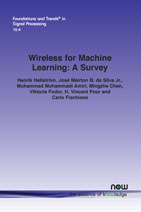Wireless for Machine Learning: A Survey
By Henrik Hellström, KTH Royal Institute of Technology, Sweden, hhells@kth.se | José Mairton B. da Silva Jr., KTH Royal Institute of Technology, Sweden | Mohammad Mohammadi Amiri, Massachusetts Institute of Technology, USA | Mingzhe Chen, Princeton University, USA | Viktoria Fodor, KTH Royal Institute of Technology, Sweden | H. Vincent Poor, Princeton University, USA | Carlo Fischione, KTH Royal Institute of Technology, Sweden
Abstract
As data generation increasingly takes place on devices without a wired connection, Machine Learning (ML) related traffic will be ubiquitous in wireless networks. Many studies have shown that traditional wireless protocols are highly inefficient or unsustainable to support ML, which creates the need for new wireless communication methods. In this monograph, we give a comprehensive review of the state-of-the-art wireless methods that are specifically designed to support ML services over distributed datasets. Currently, there are two clear themes within the literature, analog over-the-air computation and digital radio resource management optimized for ML. This survey gives an introduction to these methods, reviews the most important works, highlights open problems, and discusses application scenarios.
Wireless for Machine Learning: A Survey
This monograph covers the topic of Wireless for Machine Learning (ML). Although the general intersection of ML and wireless communications is currently a prolific field of research that has already generated multiple publications, there is little review work on Wireless for ML.
As data generation increasingly takes place on devices without a wired connection, ML related traffic will be ubiquitous in wireless networks. Research has shown that traditional wireless protocols are highly inefficient or unsustainable to support ML, which creates the need for new wireless communication methods. This monograph gives an exhaustive review of the state-of-the-art wireless methods that are specifically designed to support ML services over distributed datasets. Currently, there are two clear themes within the literature, analog over-the-air computation and digital radio resource management optimized for ML. A comprehensive introduction to these methods is presented, reviews are made of the most important works, open problems are highlighted and application scenarios are discussed.
